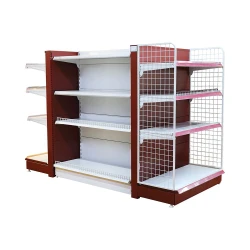Here are key elements and considerations related to retail shelving
2023-12-18
Retail shelving refers to the fixtures and systems used in retail environments to display and organize merchandise for sale. Effective retail shelving is crucial for creating an appealing shopping experience, optimizing space, and promoting products to attract customers. Here are key elements and considerations related to retail shelving:
1. Types of Retail Shelving:
- Gondola Shelving: Freestanding double-sided or single-sided shelving units often used as the primary shelving system in retail stores.
- Wall Shelving: Mounted on walls to maximize vertical space and create additional display areas.
- End Cap Displays: Shelving units placed at the end of gondola aisles to highlight featured or promotional products.
- Pegboard Shelving: Features pegs or hooks for hanging merchandise, commonly used for items like tools or accessories.
- Slatwall Shelving: Utilizes slats with grooves for adjustable hooks, brackets, and shelves, providing flexibility in display arrangements.
2. Materials:
- Metal Shelving: Durable and versatile, commonly used in grocery stores and larger retail environments.
- Wooden Shelving: Provides a warm and natural look, often used in boutique or specialty stores.
- Glass Shelving: Adds a modern and elegant touch, suitable for showcasing high-end or delicate merchandise.
3. Adjustability and Flexibility:
- Adjustable shelving allows retailers to adapt to changing merchandise sizes and display requirements.
- Some systems include shelves that can be easily repositioned or added to accommodate different product heights.
4. Shelf Types:
- Flat Shelves: Standard flat surfaces for displaying a variety of products.
- Angled Shelves: Tilted at an angle for better visibility of products, commonly used for books, magazines, or shoes.
- Wire Shelves: Open wire design for enhanced visibility and airflow, suitable for items that need ventilation.
5. Display Accessories:
- Hooks, Brackets, and Pegs: Used for hanging merchandise such as clothing, accessories, or packaged items.
- Baskets and Bins: Provide additional storage and organization for loose or small items.
- Sign Holders: Attachments for displaying product information, prices, or promotional materials.
6. Endless Aisle Displays:
- Digital screens or interactive kiosks integrated into shelving to provide additional product information, reviews, or access to online inventory.
7. Lighting:
- LED Lighting: Integrated into shelving units to illuminate products and enhance visibility.
- Spotlights: Directed lights highlighting specific products or sections.
8. Planogram Implementation:
- Designing and organizing shelving according to a planogram, which is a visual representation of how products should be arranged to maximize sales and visual appeal.
9. Point-of-Purchase (POP) Displays:
- Shelving designed for strategic placement near checkout areas to encourage last-minute purchases.
10. Versatility for Seasonal Changes:
- Retailers often need shelving systems that can be easily adjusted or reconfigured to accommodate seasonal merchandise or changing product assortments.
11. Accessibility and ADA Compliance:
- Ensuring that shelving units are accessible to all customers, including those with disabilities, in compliance with the Americans with Disabilities Act (ADA).
12. Durability and Maintenance:
- Choosing materials that are durable and easy to clean to maintain a neat and appealing store environment.
Effective retail shelving is a key element of store design and layout, influencing customer experience and purchase behavior. It involves a thoughtful combination of design, functionality, and adaptability to meet the specific needs of the retail space and the types of products being sold.



